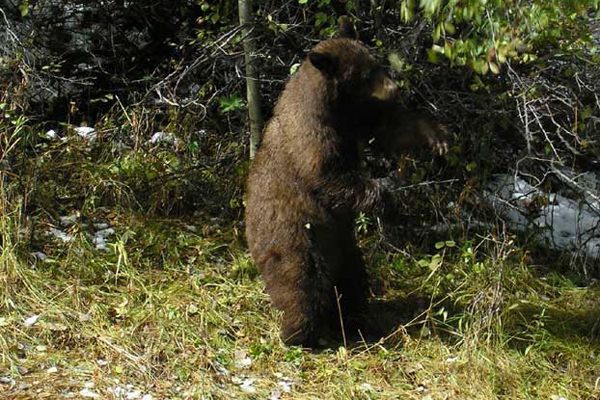Could Escaped Animals Account for Bigfoot Sightings?

Last weekend a chimpanzee was seen rampaging through a Las Vegas neighborhood. It wasn't a hoax, nor a hallucination -- and it wasn't the first time.
The Associated Press reported,
A chimpanzee who rampaged through a Las Vegas neighborhood last month made a second escape from her backyard enclosure this weekend, but her caretaker thinks she had human help this time. Timmi De Rosa says the 13-year-old chimp, CJ, didn't get loose Saturday by bending steel bars without help. She thinks someone let CJ out of her cage. De Rosa says the 180-pound animal was captured quickly and was never a threat to neighbors. On July 12, CJ and her mate Buddy broke free and roamed the neighborhood, pounding on vehicles and climbing in an unoccupied car. An officer shot and killed Buddy when the animal frightened bystanders.
What might this sort of bizarre and scary incident have to do with Bigfoot and other mysterious creatures? Plenty.
NEWS: Bigfoot and Yeti DNA Gets Serious
The field of cryptozoology doesn't merely include unknown animals like Bigfoot, but also those "out of place" -- animals known to exist but rarely if ever reported outside of their natural habitats.
If a person walking in the woods sees a large, hairy bipedal creature, he or she is likely to assume it's Bigfoot. But Bigfoot is of course not the only large hairy animal that can stand on two legs; bears, for example, can stand and even briefly walk on two legs, as can chimpanzees, bonobos, baboons and other animals.
Other large animals such as moose or elk, when seen from behind and/or in near-darkness, can also appear to be standing on two legs and therefore Bigfoot-like.
Get the world’s most fascinating discoveries delivered straight to your inbox.
In these cases the reason that an eyewitness rules out a known animal in favor of an unknown one is that he or she assumes that there are no wild animals in the area that could look like that. Clearly, that is not always the case.
As wild animals lose more and more of their native habitats they are drawn closer to cities and towns. Coyotes and bears, for example, have become an increasingly common sighting in many areas. And that's only the tip of the iceberg.
Exotic Animal Escapes
In 2010, two camels and a tiger were found in the woods in Canada. The animals were among several being moved from Nova Scotia to a private zoo outside of Toronto, and they escaped when the truck carrying them was stolen by thieves in Quebec.
In 2009 an Oklahoma couple driving home from church on U.S. 81 about an hour north of Oklahoma City swerved to avoid an eight-foot-tall, 4,500-pound elephant on the highway. It had escaped earlier that day from a circus at the Garfield County Fairgrounds, and amazingly no one had been able to track or find it.
PHOTOS: 10 Reasons Why Bigfoot's a Bust
Then of course there was the bizarre and tragic case in October 2011 when an Ohio man released his private menagerie of exotic animals into the wild before killing himself. In all nearly 60 animals including wolves, grizzly bears, lions, Bengal tigers, leopards and monkeys scattered into the woods outside of Columbus. All were (apparently) eventually recovered, though many had to be killed.
There are many other cases similar to these, and likely even more that go unreported. Some people whose exotic pets escape may not want to report it to police for fear that they will be fined or jailed (either for illegally keeping them in the first place, or for allowing them to escape), or that their animal will be shot and killed.
These misplaced animals don't always escape from private zoos or circuses. Last year a 140-pound cougar was killed on a highway in Connecticut, far outside its natural habitat. As the New York Times noted,
So where had this cougar come from? Now we know the answer, and it couldn't be more astonishing. Wildlife officials, who at first assumed the cat was a captive animal that had escaped its owners, examined its DNA and concluded that it was a wild cougar from the Black Hills of South Dakota. It had wandered at least 1,500 miles before meeting its end at the front of an S.U.V. in Connecticut.
One wonders how many people saw the cougar during its journey halfway across the United States; did anyone see the elusive creature and think it might be an unknown creature or monster?
While some of these unusual animals were recovered within hours, others spent days or weeks roaming rural areas; it's likely that they were spotted at some point. It's also important to remember that most Bigfoot sightings (like Bigfoot photos) are not clear, detailed, close-up and well-lit; most reports are merely of something large, dark, and unidentified in the woods at a distance behind trees and foliage in shadows or at dusk. Under those conditions, with some imagination just about anything can look mysterious.
Elephants in Oklahoma, camels in Canada, cougars in Connecticut and chimps in Las Vegas? Escaped and unusually mobile animals cannot, of course, explain every mysterious animal sighting -- but then again they don't have to. It only takes a few unknown reports to generate and fuel the belief that unknown animals lurk nearby.
This story was provided by Discovery News.

